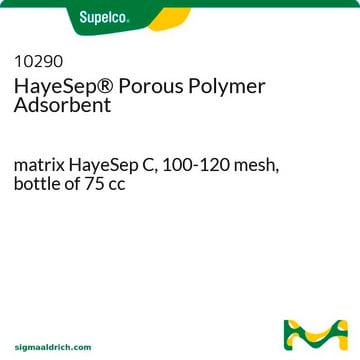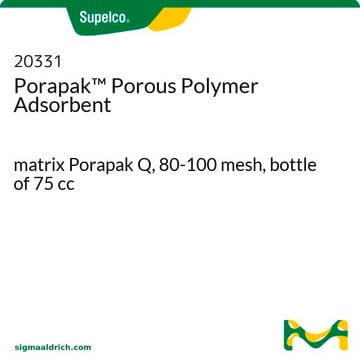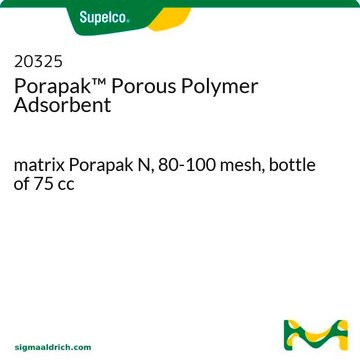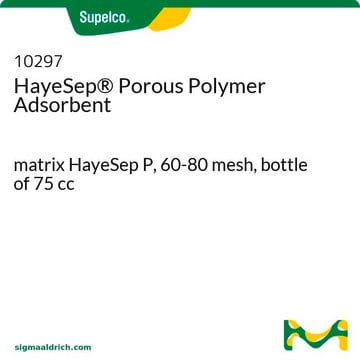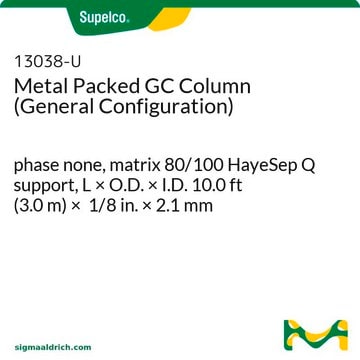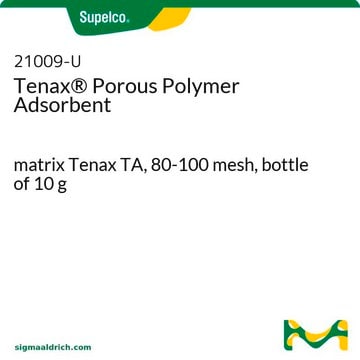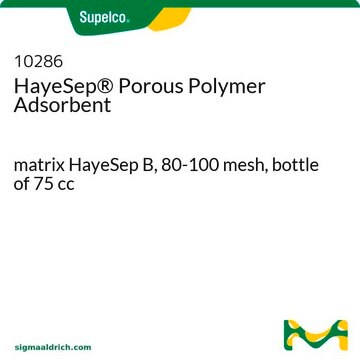추천 제품
일반 설명
HayeSep porous polymers, considered second generation materials, are consistent batch-to-batch, with minimal shrinkage and monomer bleed.
For more information about any of our adsorbents, please visit sigma-aldrich.com/adsorbents
For more information about any of our adsorbents, please visit sigma-aldrich.com/adsorbents
Porous polymers are the most suitable adsorbent for applications based on the analysis of gases, acids, amines, organics of low carbon number and water.[1] They are best suited for gas chromatography and are basically copolymers of polydivinylbenzene (DVB) which are very porous in nature ranging from mesoporous to microporous.[2] HayeSep® has a high surface area owing to its micropores thereby making it a suitable candidate for separation of gases and volatile organic compounds (VOCs). [3] Furthermore they are relatively inert and exhibit hydrophobicity.[4] HayeSep C is a copolymer of divinylbenzene and acrylonitrile.[5]
애플리케이션
HayeSep C maybe used in an experimental set-up to remove NH3 from H2SO4 aqueous solution for hydrodenitrogenation of quinolone.[6]
법적 정보
HayeSep is a registered trademark of Hayes Separation Inc.
Storage Class Code
11 - Combustible Solids
WGK
nwg
Flash Point (°F)
Not applicable
Flash Point (°C)
Not applicable
개인 보호 장비
dust mask type N95 (US), Eyeshields, Gloves
가장 최신 버전 중 하나를 선택하세요:
Trace Analysis of Specialty and Electronic Gases.
Geiger W.M and Raynor M.W. et al.
Science, 256-257 (2013)
Modern Practice of Gas Chromatography.
Grob RL and Barry EF. et al.
Science, 79-83 (2004)
Gas Chromatography in Air Pollution Analysis.
Berezkin V.G and Drugov Y.S. et al.
J. Chromatogr. Library, 50-51 (1991)
Hydrodenitrogenation of quinoline over a dispersed molybdenium catalyst using in situ hydrogen.
Lee RZ, et al.
Topics in Catalysis, 37 (2), 121-127 (2006)
Gas Chromatography.
Poole C. et al.
Science, 127-130 (2012)
활성 필터
자사의 과학자팀은 생명 과학, 재료 과학, 화학 합성, 크로마토그래피, 분석 및 기타 많은 영역을 포함한 모든 과학 분야에 경험이 있습니다..
고객지원팀으로 연락바랍니다.